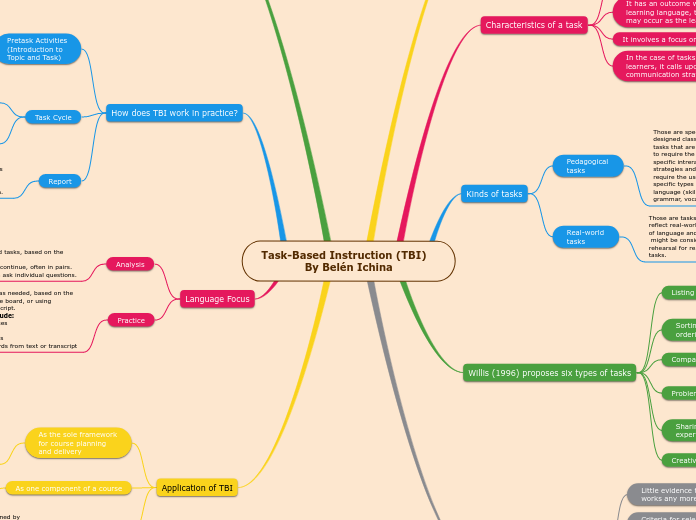Task-Based Instruction (TBI) By Belén Ichina
Application of TBI
As a technique
Teachers who find the procedures outlined by Willis unrealistic and unmanageable over a long period could still use task work from time to time as one technique from their teaching repertoire.
As one component of a course
A task strand can also serve as one component of a course, where it would seek to develop general communication skills.
As the sole framework for course planning and delivery
According to Prabhu (1987) a grammar-based curriculum was replaced by a taskbased one in a state school system, albeit only for a short period.
Language Focus
�T conducts practice activities as needed, based on the language analysis already on the board, or using examples from the text or transcript.
� Practice activities can include:
� Choral repetition of the phrases
� Sentence completion
� Matching the past-tense verbs
� Dictionary reference with words from text or transcript
Analysis
� T sets some language-focused tasks, based on the texts students.
� T starts Ss off, then students continue, often in pairs.
� T goes around to help. Ss can ask individual questions.
How does TBI work in practice?
Report
� T asks some pairs to report briefly to the whole class so everyone can compare findings, or begin a survey.
� T chairs, comments on the content of their reports, rephrases perhaps, but gives no overt public correction.
Task Cycle
Planning
� Ss draft and rehearse what they want to say or write.
� T goes around to advise students and helping them.
� T can encourage peer-editing and use of dictionaries.
� The emphasis is on clarity, organization, and accuracy,
Task
�The task is done by Ss (in pairs or groups)
� T walks around and monitors, encouraging in a supportive way in the target language.
� T helps Ss to formulate what they want to say
Pretask Activities
(Introduction to Topic and Task)
� T helps Ss to understand the theme.
� Ss may do a pre-task
� Ss can be given preparation time to think
� Ss can hear a recording of a parallel task being done
� If the task is based on a text, Ss read a part of it.
P-P-P lesson format
Advocates of TBI reject this model
They claim that students do not develop fluency or progress in their grammatical development through a P-P-P methodology.
Production
Students practice using the new structure in different contexts
often using their own content or information, in order to develop fluency with
the new pattern.
Practice
Students practice using the new structure in a controlled context, through drills or substitution exercises.
Presentation
The new grammar structure is presented, often by means of a conversation or short text. The teacher explains the new structure and checks students’ comprehension of it.
Issues in Implementing TBI
In courses that have specific instructional outcomes to attain
TBI may seem too vague as a methodology to be widely adopted
Classroom processes
TBI addresses classroom processes rather than learning outcomes is also an issue.
Content issues
Making it of little relevance to those concerned with CBI or mainstreaming.
Task work
They serve to develop fluency at the expense of accuracy, as with some of the other activities suggested within a CLT framework
Criteria for selecting and sequencing tasks
They are also problematic, as is the problem of language accuracy.
Little evidence that it works any more effectively
Than the P-P-P approach it seeks to replace
Willis (1996) proposes six types of tasks
Creative tasks
Students prepare plans for redecorating a house
Sharing personal experiences
Students discuss their reactions to an ethical or moral dilemma.
Problem solving
Students read a letter to an advice columnist
and suggest a solution to the writer’s problems.
Comparing
Students compare ads for two different
supermarkets.
Sorting and ordering
Students work in pairs and make up a list of the most important characteristics of an ideal vacation.
Listing tasks
Students might have to make up a list of things they would pack if they were going on a beach vacation.
Kinds of tasks
Real-world tasks
Those are tasks that reflect real-world uses of language and which
might be considered a rehearsal for real-world tasks.
For example: A role play in which students practice a job interview
Pedagogical tasks
Those are specially designed classroom tasks that are intended to require the use of specific intreractional strategies and may also require the use of specific types of language (skills, grammar, vocabulary).
For example: A task in which two learners have to try to find the number of differences between two similar pictures.
Characteristics of a task
In the case of tasks involving two or more learners, it calls upon the learners’ use of communication strategies and interactional skills.
It involves a focus on meaning.
It has an outcome which is not simply linked to learning language, though language acquisition may occur as the learner carries out the task.
It is something that learners do or carry out using their existing language resources.
What is it?
It is a methodology that can be regarded as developing from a focus on classroom processes
TBI
It focuses mainly in the use of tasks and sees them as the primary unit to be used, both in planning teaching and in classroom teaching.
Advocates of
TBI say
Grammar and other dimensions of communicative competence can be developed as a by-product of engaging learners in interactive tasks
Language learning will be the result
Creating the right kinds of interactional processes in the classroom, and the best way to create these is to use specially designed instructional tasks.









